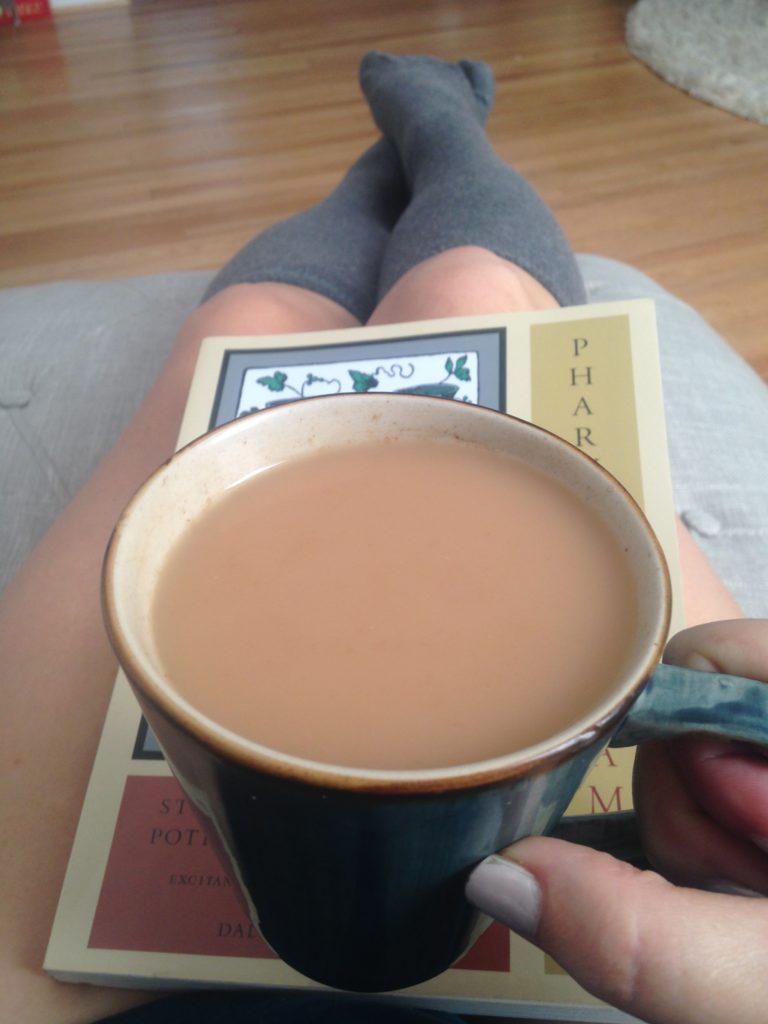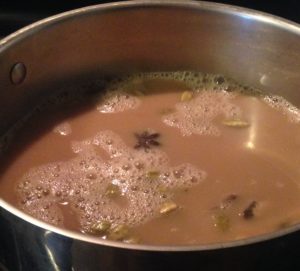“Alice laughed: “There’s no use trying,” she said; “one can’t believe impossible things.” “I daresay you haven’t had much practice,” said the Queen. “When I was younger, I always did it for half an hour a day. Why, sometimes I’ve believed as many as six impossible things before breakfast.”

chai & knee socks & book = fall magic
A couple of days ago, I helped a friend avoid succumbing to a UTI with a couple of ad hoc herbal remedies and a couple of tongue readings via text message. I didn’t do much, really. Her body (and a very good night’s sleep!) did the heavy lifting. As open as she’s been to my work, I could hear that the experience of feeling herself getting sick, taking herbs, and having the pattern resolve itself without any further intervention had made an impact on her that she didn’t quite expect.
It’s one thing to be open to something countercultural (both veganism and Chinese Medicine are pretty countercultural, in my book.) It’s another to actually experience the world in a new way. If you really want to change, grow, or transform, you’ve got to open yourself to new experiences. And you’ve got to be willing to let those experiences change your beliefs.
Enduring changes come from the deep, not from forced effort on the surface of things. Behavior follows belief, but it’s possible to behave your way into new ways of experiencing the world. Let’s try it. Making chai* is a good place to start.
*Please don’t call it “chai tea.” The word “chai” is Hindi for “tea.” If you want to get more specific, you can call this “Masala Chai,” or “spiced tea.”
How to Make Chai
You don’t need a recipe. In fact, I hope you’ll give this a whirl without Googling for more specific recipes! You just need this basic technique and the willingness to experiment. There’s something healing about trusting yourself enough to throw some spices in a pot and improvise.
Step One: Simmer Herbs & Spices
Look through your spice cabinet for anything vaguely Fall-esque or Chai-like. Cloves, Cinnamon Sticks, Star Anise, Cardamom Seeds or Pods, Vanilla beans, and Fennel Seeds are all excellent candidates. A few black peppercorns make a great addition if you like a bit of a kick!
The two spices that I must have for a masala chai are fresh ginger root and cardamom pods. Sometimes, those are the only spices I include. Without ginger and cardamom, it’s just not going to work for me. (But remember–your taste might be different. Don’t hesitate to experiment!)
Sometimes, I add medicinal herbs to my chai, too. Astragalus root is my most frequent choice (my Spleen always needs all the help it can get) but I’ve also been known to toss in burdock root, codonopsis, and turmeric. (I’ll be sharing more about cooking with medicinal herbs this month. For now, it’s enough to start with things you already have on-hand. The first step is to start getting comfortable with the fire burn and cauldron bubble (so-to-speak) aspects of cooking and herbcraft.)
How much spice and how much water? Eyeball it! If your brew is too intense, water it down. If it’s weak, simmer it longer. You really can’t mess this up. I repeat: you cannot mess this up.
Step Two: Add Tea and Steep
Once you’ve got a nice pot of spiced liquid, it’s time to add your tea. If you avoid caffeine, decaf black tea will work beautifully. You can also try Rooibos, which has a mild flavor that complements the spices.
I tend to use a very basic black tea (in teabags) for my chai. The spices add so much flavor that this is a perfect place to use a less expensive tea without sacrificing your enjoyment. I use about 1 teabag per 8 oz of liquid. (Slightly weaker than if I were drinking the tea without spices.)
Turn the burner off and allow the tea to steep as long as it needs to, according to the kind of tea you’ve chosen.
Step Three: Milk & Sugar?
I like my chai to be creamy and a little sweet so I add a generous amount of soymilk (you can use any milk that you like!) and something to sweeten it a little. Sometimes, I’ll use a drop or two of liquid stevia and a scant tablespoon of sugar. If you prefer an unsweetened chai, no problem!

Step Four: Rinse & Repeat
The point about not giving you a recipe is that I want you to give yourself permission to experiment. You can’t do this wrong. And the best way to get comfortable with herbs — whether for culinary or medicinal use — is to stop reading and start experiencing.
